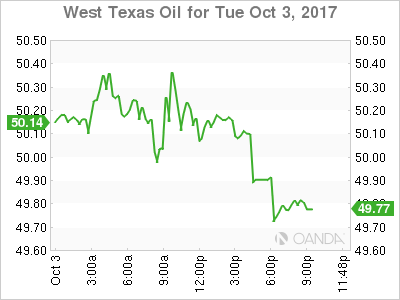The Canadian dollar climbed against the US dollar on Tuesday. The hawkish words from Bank of Canada (BoC) Deputy Governor Sylvain Leduc. The BoC official said that while growth in Canada is expected to decline, it will still exceed the rate of potential output. While Leduc did not comment about monetary policy a higher output economy is likely to experience higher inflation that could in turn trigger higher rates.
The Canadian central bank was criticized for hiking rates in September with little warning for markets. This contrasted heavily against the comments in June that gave a heads up to investors about an upcoming rate hike. The two rate raises in 2017 could still be joined by another before the end of the year, but only if economic growth does not lose too much momentum. Leduc’s words seem to support that theory.
Oil declined on Tuesday as supply continues to be plentiful as Organization of the Petroleum Exporting Countries (OPEC) and the United States have increased production. The geopolitical situation in Northern Iraq is an ongoing concern but so far there hasn’t been any disruptions of crude output. The API oil inventories were released this afternoon and showed a drawdown of 4.1 million barrels and a large buildup of gasoline stocks.

The USD/CAD lost 0.224 percent on Tuesday. The currency pair is trading at 1.2486 after words from Bank of Canada (BoC) Deputy Governor Leduc saw the lone advanced versus the greenback. The BoC quickly matched the two rate hikes from the U.S. Federal Reserve with a 25 basis points rate hike in July and another in September. The Canadian benchmark interest rate is now 1.00 percent compared to the 100–125 basis points range for Fed funds rate. While the Fed has continued to support a third rate hike, the economy has slowed down. The situation in Canada turned suddenly with bigger than expected growth in the second quarter that gave the central bank confidence to hike borrowing costs.
The final quarter of the year will be crucial for how both central banks decide regarding monetary policy. The Fed has made it clear it will not wait for inflationary pressures before it raises rates. The BoC might not have to make that choice as inflation continues to move higher.

Energy prices lost 0.304 in the last 24 hours. The price of West Texas Intermediate is trading at 50.11 with crude in a tight trading range awaiting US economic indicators and crude inventories on Wednesday. The recovery of US refineries and drilling operations following the hurricanes in the US has ignited a sell off as investors foresee an increase in supply with no change to demand in the short term.
Comments form Organization of the Petroleum Exporting Countries (OPEC) Secretary General about compliance with output limits is high. Northern Iraqi supply continues pass through Turkey as the fate of independence is still uncertain. Traders will be monitoring the release of the US crude inventories by the Energy Information Administration (EIA) on Wednesday, October 4 at 10:30 am EDT. US stocks are expected to have dropped by 500,000 barrels last week.
Market events to watch this week:
Wednesday, October 4
4:30 am GBP Services PMI
8:15 am USD ADP Non-Farm Employment Change
10:00 am USD ISM Non-Manufacturing PMI
10:30 am USD Crude Oil Inventories
3:15pm USD Fed Chair Yellen Speaks
8:30 pm AUD Retail Sales m/m
8:30 pm AUD Trade Balance
Thursday, October 5
8:30 am CAD Trade Balance
8:30 am USD Unemployment Claims
Friday, October 6
8:30 am CAD Employment Change
8:30 am CAD Unemployment Rate
8:30 am USD Average Hourly Earnings m/m
8:30 am USD Non-Farm Employment Change
8:30 am USD Unemployment Rate













